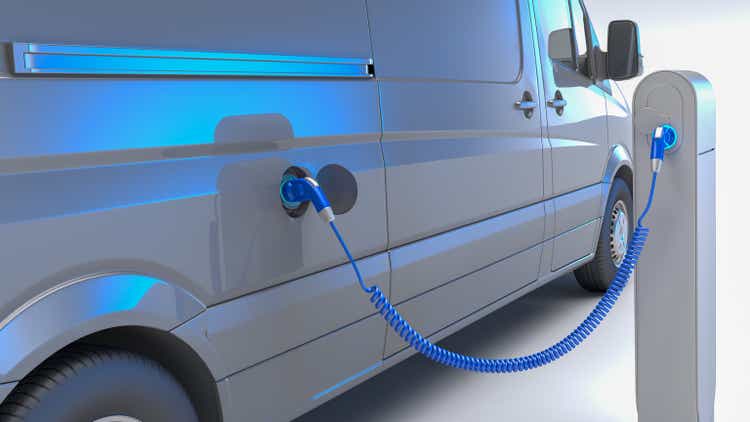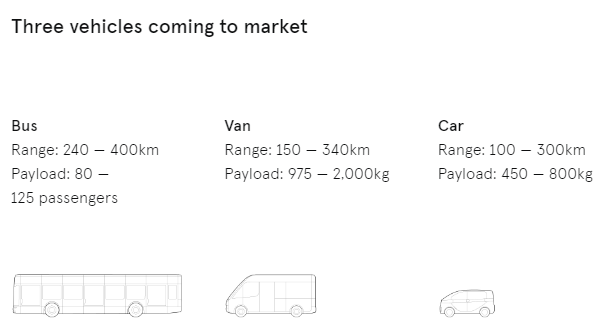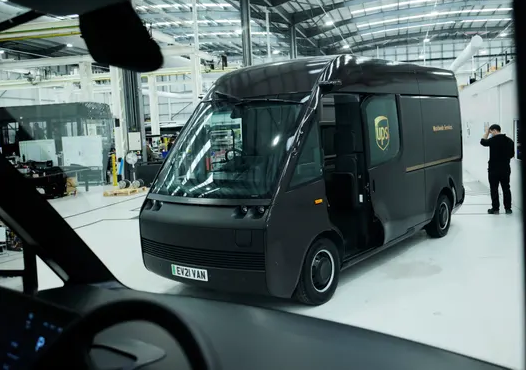Franck-Boston/iStock via Getty Images
Arrival Group (NASDAQ:ARVL) is a high-risk investment within the EV sector, with strong upside potential possible if the company executes on its business plan. The start of Van deliveries in the coming months is a key milestone for Arrival and can be an important catalyst for investors to believe in its investment case.
Company Overview
Arrival is an integrated electric vehicle (EV) company, aiming to change the EV industry by betting on a different production approach through smaller and automated factories. It has a total workforce of about 2,700 people and is based in the U.K.
Arrival was founded in 2015 but has been listed only since the end of 2020 through a SPAC merger. Like many EV start-ups, its share price and market value exploded higher during the following months, but like many bubbles, it burst and nowadays Arrival’s share price is trading 95% lower from its all-time highs. While at some point Arrival was valued at about $13 billion, its current market value is only around $1.2 billion, being therefore a small company by this measure.
Its free float is only about 30% of total capital, thus market liquidity can be somewhat low for larger investors, but for retail investors, it is more than enough given that its daily value traded is usually above $5 million. Note that the remaining 70% of Arrival’s capital is owned by Kinetic Sarl, an investment company based in Luxembourg owned by Arrival’s founder and CEO Denis Sverdlov.
Business Model
Arrival is not just another start-up that is developing EVs, as the company has higher ambitions than that. Arrival is reinventing both the design and production of EVs, which if successful, can be a great competitive advantage in the auto industry.
Instead of following the industry’s usual production methods, Arrival is rethinking the production method using proprietary components, composite materials and robotics to produce its vehicles, eliminating legacy processes in its factories. Furthermore, Arrival’s technologies and components are shared across all vehicle types, being a key benefit of its different business model.
Additionally, while the auto industry is built on the premise of economies of scale, which means automakers need to produce a large number of vehicles to be profitable and usually production is concentrated in a few number of factories, Arrival aims to produce its EVs in microfactories through, potentially, a large number of facilities.
These microfactories will be installed locally with a small footprint, and will therefore have much lower capital requirements than typical car factories. According to Arrival, the cost of a microfactory is about $50 million and can be operational within six months of s site’s readiness, allowing the company to be very flexible on its growth plans and achieve rapid deployment worldwide over the coming years and adapt its production capacity to customer demand.
This different approach may enable Arrival to offer EVs at a very competitive price compared to other EVs and even compared to internal combustion engine (ICE) competitors, which will be a huge advantage to be successful in the auto industry over the long term. Indeed, Arrival claims that its EVs will be the first to cost the same as ICE equivalents on a total cost of ownership basis, which would be a great milestone for greater adoption of zero-emission vehicles in the next few years.
Moreover, Arrival is focusing on a specific part of the auto market and is not targeting the passenger car market, which means Arrival will not be a direct competitor of legacy automakers. Instead, Arrival is focusing its product offering in the lightweight commercial segment, through three vehicles, namely a Van, a Bus, and a Car. Note that the car will potentially be offered for robotaxi services or ride-sharing platforms while Arrival may eventually sell it to individual customers as well if there is demand for that.
Vehicles (Arrival)
Production Plans
Arrival had ambitious production plans when it was listed through the SPAC merger in 2020, but like what happened to other start-up EV companies, these goals were revised down in recent months. At the time, Arrival expected to develop four microfactories and start vehicle production of the Van in 2022, but since the middle of 2021 Arrival’s management started to postpone the execution timeline and, more recently, has been more focused on the development and production start of the Arrival Van, while the bus and the car are being pushed back. Moreover, only two microfactories are planned now, while others may be added in the future.
While the Bus received EU certification in May 2022, which is a critical step to start trials with customers, and was, supposedly, more advanced to come to the market, the Van also received EU certification and European Whole Vehicle Type Approval (EUWVTA) last June and seems to be Arrival’s first vehicle to start production. Arrival expects to start production of the van at its Bicester (U.K.) factory during the third quarter of 2022, and to start deliveries to customers in the following months.
Regarding the Arrival Bus, while it was expected to be produced initially in the company’s U.S. factory, this was shifted to the U.K. to be closer to its initial customer (First Bus operator in the U.K.). The Arrival Bus has already been in trial tests with Enel (OTCPK:ENLAY) in Italy, Regarding the Arrival Car, this was projected on collaboration with Uber Technologies (UBER) for the purpose of ride hailing, and is expected to produce this car for Uber starting in Q3 2023.
However, last week, it was reported that Arrival is pausing the bus and car projects to save costs, and instead is putting all efforts on the production of the Arrival Van and may resume other projects when it starts to generate revenue. The company is focused on achieving its business goals until late 2023 with its $500 million of cash available, which seems sensible considering the current uncertain macroeconomic environment and the likely difficulty for unprofitable companies, like Arrival, to raise capital in the next few months. Arrival is planning to cut costs by some 30%, which can potentially impact some 30% of its global workforce, to avoid raising new equity at the current depressed levels.
Therefore, Arrival’s production plans are now much less ambitious and only the Van should start production and customer deliveries in the short term. Arrival expects to deliver some 400-600 Vans by the end of this year, much lower than its annual vehicle capacity of around 20,000 units for its two microfactories. Nevertheless, the start of production of the Van will be a great milestone for the company and a proof of concept, considering that right now the company does not have a proven manufacturing process.
Note that Arrival has a significant number of pre-orders for its vehicles (about 149k at the end of Q2 2022), but these are non-binding letters of intent, from commercial customers such as UPS (UPS), thus they can be cancelled and therefore are only ‘good’ if eventually Arrival is capable of fulfilling them. At this stage, in my opinion, what is more important is for Arrival to start production of its Van and show that its business model works, while demand is very likely to exist for its vehicles as the world turns to EVs over the next decade.
Arrival Van (Arrival)
Financial Profile
Regarding financials, Arrival is still a start-up company and is not generating revenue, thus its financials are limited to its costs, investments and cash position. Arrival has reported today its Q2 2022 earnings, ending the quarter with some $513 million of cash on its balance sheet, which should be enough to finance its operations over the next year at least. It also established a $300 million At-the-Market (ATM) financing platform to sell stock from time to time, which will also help the company to operate the business through 2023 without raising more capital.
For shareholders this is a positive step, considering that the dilution risk was quite significant and, at least, during the next 16 months, this risk seems to be limited to $300 million, which at its current market value represents a dilution of about 25% and is acceptable for a startup company. The dilution could be much higher as the company could easily need $500 million to $1 billion to ramp up production of four microfactories and start delivery of its three planned vehicles during 2023, thus its current business decision to scale back ambitions to focus on the Van seems to be the right one, as dilution to current shareholders would be huge if Arrival maintained its targets established in 2020.
Arrival said that it expects to start production of the Van this quarter and deliver the first units to UPS by the end of the year and start production in its U.S. microfactory during 2023. This is an important milestone for Arrival and a proof of concept of its different manufacturing approach, and an important catalyst for a higher share price in the coming months.
Regarding demand, Arrival ended the quarter with some 149k non-binding orders for its vehicles, which if completed can represent about $6 billion in revenue. Not surprisingly, in Q2 the company reported a loss of $89.6 million, compared to a loss of $56 million in Q1 2021, and its adjusted EBITDA loss was $76 million. Capital expenditures for the period were $95 million to set up its Bicester factory, and Arrival expects to invest only some $40-$60 million in capex in the second half of the year.
Even though Arrival expects to deliver some 20 Vans during the Q4 to customers, due to delivery times and customer acceptance requirements, Arrival does not expect to generate revenue this year. Note that previously Arrival guided for 400-600 Van deliveries in 2022, thus this guidance is a big adjustment downwards. This also means that the company will continue to burn cash in the coming quarters, and expects to end the year with $300-$350 million in cash, including some $90 million of ATM proceeds.
Going forward, it is difficult to forecast how many vehicles Arrival will deliver and how much revenue it will generate, as the company is constantly adapting its operations to capital constraints, thus Arrival is expected to continue to invest in its business growth for some years down the road and the prospects of reaching breakeven are low at least over the next two to three years.
Conclusion
At this stage, Arrival is a speculative investment within the EV sector, having significant upside potential if it can execute on its vision. However, this is something that will require significant investments, thus the company should continue to report losses for many years and the risk of not securing funding should not be overlooked in the current environment with investors less willing to fund start-ups compared to just a few months ago.
Therefore, the company’s strategic turn to preserve cash instead of pursuing growth in the short term seems sensible, even if it is at the expense of scrapping previous growth targets. At this point, I think investors should forget older targets, as building a new brand and manufacturing process in the auto industry is hard and will take much more time than Arrival was expecting.
Nevertheless, compared to other EV startups, I see Arrival as potentially having some edge and competitive advantage over the long term if it can deliver on its goals, which is key to its long-term success. For me personally, I’m not buying more shares until the company starts to deliver the Van to customers and shows that it can deliver a quality vehicle while ramping up production from there should be much easier and, most likely, will be a key catalyst for higher investor confidence in Arrival’s investment case.


Be the first to comment